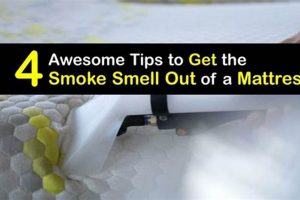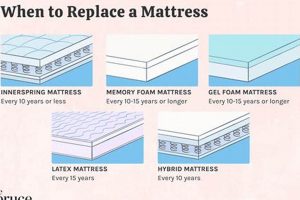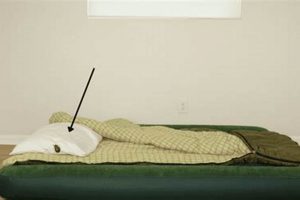Eradicating these pests from bedding surfaces presents a significant challenge due to the nature of fabric and its capacity to harbor these insects and their eggs. Mattress infestations require a multi-faceted approach involving thorough cleaning and targeted treatments.
Addressing a mattress infestation is crucial for maintaining a healthy home environment, preventing further spread of the parasites to pets and humans, and avoiding potential skin irritation or allergic reactions. Historically, various methods, from natural remedies to chemical applications, have been employed to eliminate these infestations, highlighting the persistent need for effective solutions.
The following sections will outline the necessary steps to effectively eliminate a flea problem from a mattress, encompassing preparatory measures, cleaning techniques, and preventative strategies to ensure long-term control.
Effective Strategies for Eliminating Fleas from Mattresses
Eliminating a flea infestation within a mattress requires a strategic and thorough approach. The following tips outline key steps to achieve effective and lasting results:
Tip 1: Thorough Vacuuming: Begin by meticulously vacuuming the entire mattress surface, including seams, tufts, and crevices. Use a vacuum cleaner with a strong suction and a crevice tool to reach difficult areas. Dispose of the vacuum bag or empty the canister immediately after use, preferably outside, to prevent re-infestation.
Tip 2: Hot Water Washing of Bedding: Wash all bedding, including sheets, pillowcases, blankets, and mattress protectors, in hot water (at least 130F or 54C). The high temperature is essential to kill fleas and their eggs. Dry the items on the highest heat setting in a clothes dryer.
Tip 3: Steam Cleaning: Utilize a steam cleaner to treat the mattress surface. The high temperature of the steam will penetrate the fabric and kill fleas and their eggs. Ensure the mattress is completely dry after steam cleaning to prevent mold growth.
Tip 4: Application of Diatomaceous Earth: Food-grade Diatomaceous Earth (DE) is a natural desiccant that can effectively dehydrate and kill fleas. Lightly dust the mattress surface with DE, focusing on seams and crevices. Allow it to sit for several days before vacuuming thoroughly. Exercise caution to avoid inhaling DE, as it can be an irritant.
Tip 5: Insecticide Application (If Necessary): If the infestation persists, consider using a mattress-safe insecticide. Carefully follow the manufacturer’s instructions and apply the product sparingly. Ensure the room is well-ventilated during and after application. Allow the mattress to dry completely before covering it with bedding.
Tip 6: Regular Monitoring and Maintenance: After treatment, regularly monitor the mattress for any signs of flea activity. Vacuum frequently and wash bedding regularly to prevent re-infestation.
Implementing these strategies consistently offers a comprehensive solution for eliminating fleas from mattresses, contributing to a cleaner and healthier sleep environment.
The subsequent sections will address preventative measures to further minimize the risk of future infestations, ensuring a flea-free environment.
1. Vacuum Thoroughly
Thorough vacuuming represents a foundational step in eradicating flea infestations from mattresses. Its effectiveness stems from the physical removal of fleas, eggs, larvae, and pupae present within the mattress fibers, thereby reducing the overall flea population and interrupting their life cycle.
- Immediate Population Reduction
Vacuuming promptly removes a significant portion of the existing flea population. Adult fleas, along with their readily dislodged eggs, are suctioned away, preventing immediate reproduction and continued infestation. This action provides an initial control measure while other treatments are considered or applied.
- Larval Habitat Disruption
Flea larvae reside deep within mattress fibers, feeding on organic debris and flea feces. Vacuuming disrupts this habitat, removing their food source and exposing them to environmental stressors. This intervention weakens the larval population, making them more susceptible to subsequent control measures.
- Pupal Stage Removal
While flea pupae are relatively resistant to many insecticides, vacuuming can physically remove them from the mattress. The physical action of the vacuum cleaner dislodges the pupal cocoons, which can then be disposed of, preventing the emergence of new adult fleas. This step is crucial, as pupae can remain dormant for extended periods.
- Enhanced Treatment Efficacy
Thorough vacuuming prepares the mattress for subsequent treatments, such as steam cleaning or the application of diatomaceous earth. By removing surface debris and loosening flea eggs and larvae, vacuuming allows these treatments to penetrate deeper into the mattress fibers, maximizing their effectiveness. A clean surface ensures that the treatment directly targets the remaining fleas and their developmental stages.
The multifaceted benefits of meticulous vacuuming highlight its critical role in managing mattress-based flea infestations. By addressing various stages of the flea life cycle and optimizing the efficacy of subsequent treatments, this method serves as an indispensable component of a comprehensive flea eradication strategy.
2. Wash Bedding Hot
The application of high-temperature washing to bedding components directly contributes to flea eradication efforts. Fleas, in all life cycle stages, exhibit susceptibility to extreme temperatures. Immersion in hot water denatures their proteins, disrupting essential biological processes and resulting in mortality. The efficacy of washing bedding hot is predicated on achieving and maintaining a water temperature sufficient to penetrate fabric fibers and envelop all potential flea harborages.
For instance, a standard washing machine cycle utilizing hot water (typically exceeding 130F or 54C) effectively eliminates fleas residing within sheets, pillowcases, blankets, and mattress protectors. The combined action of heat and agitation further dislodges fleas and their eggs, ensuring their removal during the rinsing process. Neglecting this step diminishes the overall impact of flea control measures, as surviving fleas can readily re-infest the mattress and surrounding areas. Furthermore, this method is non-toxic, presenting a safe alternative to chemical treatments for households with children or pets. Practical application necessitates verifying the washing machine’s temperature settings and ensuring adequate wash times to guarantee thorough flea elimination.
In summary, washing bedding in hot water constitutes a fundamental and effective component of a comprehensive strategy. This action addresses flea infestations by directly targeting and eliminating these pests at all life stages without the use of harmful chemicals. Its consistent application, coupled with other control methods, contributes significantly to achieving and maintaining a flea-free environment, specifically within the mattress and its associated bedding components. The primary challenge lies in ensuring sufficient water temperature and wash duration to achieve optimal results, underscoring the importance of adhering to established guidelines for effective flea control.
3. Steam Clean Mattress
Steam cleaning mattresses represents a targeted approach within the broader strategy of eliminating flea infestations. The process leverages the high temperature of steam to penetrate mattress fibers, directly impacting fleas and their developmental stages. Its relevance lies in offering a chemical-free alternative capable of reaching areas inaccessible to conventional cleaning methods.
- Thermal Disruption of Flea Biology
Steam, applied at temperatures exceeding 212F (100C), disrupts the biological processes of fleas. The intense heat denatures proteins within the flea’s body, leading to rapid mortality. This thermal shock affects adult fleas, larvae, and eggs, effectively halting their development and preventing further reproduction. Example: Direct steam application on a visible cluster of fleas results in their immediate demise. The implication is a reduction of the active flea population within the mattress.
- Penetration of Mattress Fibers
Unlike surface treatments, steam effectively penetrates the dense fibers of a mattress. This penetration is crucial for reaching fleas and eggs that reside deep within the mattress layers, escaping conventional cleaning methods. Example: Steam applied to a multi-layered mattress effectively heats the internal fibers, targeting hidden flea populations. The implication is a more thorough treatment, addressing both surface and subsurface infestations.
- Minimal Chemical Residue
Steam cleaning offers a chemical-free solution for flea eradication. This is particularly beneficial for households with sensitivities to chemical insecticides, including those with children or pets. Example: A family opting for steam cleaning avoids the potential health risks associated with chemical treatments. The implication is a safer and more environmentally friendly approach to flea control within the home.
- Sanitization and Deodorization
Beyond flea elimination, steam cleaning sanitizes the mattress by killing bacteria and other microorganisms. The process also helps to neutralize odors associated with flea infestations and accumulated dirt and debris. Example: A steam-cleaned mattress exhibits a noticeable reduction in musty or unpleasant odors. The implication is an improved overall hygiene and comfort level associated with the mattress.
The facets of steam cleaning mattresses underscore its multifaceted role in addressing flea infestations. By combining thermal disruption, deep fiber penetration, chemical-free application, and sanitation benefits, it represents a comprehensive method for achieving and maintaining a flea-free sleep environment. Its effectiveness relies on proper application techniques and equipment to ensure adequate steam penetration and coverage, ultimately contributing to successful flea eradication.
4. Diatomaceous Earth
Diatomaceous Earth (DE), specifically the food-grade variety, functions as a desiccant in the context of flea eradication from mattresses. Its application leverages the microscopic, abrasive nature of the fossilized diatoms, which compose the powder. These diatoms damage the exoskeletons of fleas, leading to dehydration and subsequent mortality. The effectiveness hinges on the direct contact between DE and the flea, making proper application techniques paramount. An example is lightly dusting the mattress surface and seams, ensuring the powder reaches areas frequented by fleas. This intervention creates a hostile environment for the insects, disrupting their life cycle within the confines of the mattress. The significance lies in DE’s non-toxic nature to mammals when ingested in small quantities, offering a safer alternative to chemical insecticides.
The application of DE to a mattress necessitates careful consideration of potential drawbacks. Over-application can lead to respiratory irritation, particularly in enclosed spaces. Thus, a thin, even layer is recommended, followed by thorough vacuuming after several days to remove excess powder. In instances where a heavy infestation is present, DE can be combined with other methods, such as steam cleaning, to enhance its efficacy. Real-world applications have demonstrated the successful elimination of fleas from mattresses using this integrated approach, reducing the reliance on chemical treatments and minimizing potential adverse effects on human health and the environment. However, success is contingent upon consistent and precise application, coupled with rigorous monitoring for signs of re-infestation.
In summary, Diatomaceous Earth represents a valuable tool in the strategy for eliminating fleas from mattresses. Its efficacy as a desiccant, combined with its relative safety compared to chemical alternatives, makes it a practical choice for many households. Challenges associated with its application can be mitigated through careful technique and monitoring. DE serves as an important component of a comprehensive flea control plan, contributing to a healthier and more pest-free sleeping environment. The understanding of DE’s properties and proper application is key to its successful implementation, maximizing its benefits while minimizing potential risks.
5. Monitor Regularly
Regular monitoring constitutes a critical element in the comprehensive strategy for eliminating flea infestations from mattresses. Its importance stems from the dynamic nature of flea populations and the potential for resurgence even after initial treatment efforts. This systematic observation allows for the early detection of any surviving fleas or newly hatched individuals, facilitating prompt intervention and preventing a full-scale re-infestation.
- Early Detection of Resurgence
Consistent monitoring enables the identification of flea activity before the population becomes widespread. Visual inspection of the mattress, particularly along seams and crevices, can reveal the presence of adult fleas or flea dirt (feces). Early detection allows for targeted retreatment efforts, minimizing the need for extensive and potentially disruptive interventions. Example: Noticing a single flea on a white sheet prompts immediate vacuuming and localized treatment. Implication: Prevents a small infestation from escalating into a larger problem.
- Assessment of Treatment Effectiveness
Regular observation provides a means to evaluate the efficacy of initial treatment methods. A reduction in flea sightings or the absence of new flea dirt indicates successful control. Conversely, persistent or increasing flea activity signals the need to adjust treatment strategies. Example: Monitoring flea traps placed near the mattress reveals a consistent catch rate despite initial treatments. Implication: Highlights the need to re-evaluate and potentially intensify control measures.
- Identification of New Infestation Sources
Monitoring can help identify external sources of flea introduction, such as pets or other infested areas within the home. Observing pets for excessive scratching or signs of fleas, as well as inspecting carpets and upholstery, can pinpoint the origin of the infestation. Example: Finding fleas on a pet bed prompts immediate treatment of the pet and thorough cleaning of its bedding. Implication: Prevents repeated re-infestation of the mattress from an external source.
- Prevention of Widespread Infestation
Consistent monitoring minimizes the risk of fleas spreading to other areas of the home. By detecting and addressing localized infestations promptly, the likelihood of fleas colonizing carpets, furniture, or other textiles is significantly reduced. Example: Regularly checking areas adjacent to the mattress for flea activity prevents their migration to nearby surfaces. Implication: Contains the infestation to a limited area, simplifying control efforts and minimizing overall disruption.
The significance of regular monitoring in the context of eliminating fleas from mattresses lies in its proactive approach to pest management. By continuously assessing the effectiveness of control measures, identifying new infestation sources, and preventing the spread of fleas, monitoring serves as a crucial safeguard against re-infestation and ensures long-term success in maintaining a flea-free sleeping environment. Without this diligence, the efforts put into initial treatments can be quickly undermined, leading to a frustrating cycle of recurring infestations.
Frequently Asked Questions
The following questions address common concerns regarding the elimination of fleas from mattresses, providing detailed information to facilitate effective control.
Question 1: Is professional pest control necessary for mattress flea infestations?
Professional intervention becomes advisable when infestations are severe or persistent despite diligent application of home remedies. Pest control professionals possess specialized equipment and expertise in addressing complex infestations and can provide targeted treatments.
Question 2: Can fleas live inside a memory foam mattress?
Fleas can indeed inhabit memory foam mattresses. The porous nature of the material provides ample hiding places for fleas and their eggs. Effective treatment requires thorough penetration of cleaning and treatment agents into the foam.
Question 3: How long does it take to completely eliminate fleas from a mattress?
The timeline for complete eradication varies depending on the severity of the infestation and the consistency of treatment efforts. In most cases, a multi-week approach combining cleaning, treatment, and monitoring is necessary to ensure full elimination of all life stages.
Question 4: Are natural remedies effective for flea infestations in mattresses?
Natural remedies, such as diatomaceous earth, can be effective as part of a comprehensive approach. However, their efficacy is contingent upon proper application and may not be sufficient for severe infestations. Professional pest control might be necessary.
Question 5: Can fleas survive washing in a standard washing machine?
Fleas can survive washing if the water temperature is not sufficiently high. Water temperatures exceeding 130F (54C) are essential for killing fleas and their eggs during the washing process. Always verify the washing machine’s temperature settings before laundering bedding.
Question 6: Is it safe to sleep on a mattress after treating it for fleas?
The safety of sleeping on a treated mattress depends on the methods and products used. If chemical insecticides were applied, strictly adhere to the manufacturer’s instructions regarding drying and ventilation times. For natural remedies, ensure all excess powder is thoroughly vacuumed before resuming use.
These FAQs provide a foundation for understanding the complexities of addressing flea infestations in mattresses. Applying this knowledge contributes significantly to achieving effective and lasting results.
The subsequent sections will explore preventative measures to minimize the risk of future infestations.
Concluding Strategies for Flea Removal from Mattresses
This exploration of how to get fleas out of mattress has outlined a multi-faceted approach, encompassing immediate interventions such as vacuuming and hot water washing, as well as ongoing strategies like regular monitoring and preventative measures. These interventions, properly implemented, are essential for minimizing the presence and impact of these pests within the sleeping environment.
The information presented underscores the necessity of consistent diligence and informed action. By adhering to these principles, a safer and more hygienic sleeping environment can be achieved, safeguarding both physical health and overall well-being from the adverse effects of flea infestations. Continued vigilance remains crucial for long-term success.







